#caenagnathids
Explore tagged Tumblr posts
Text
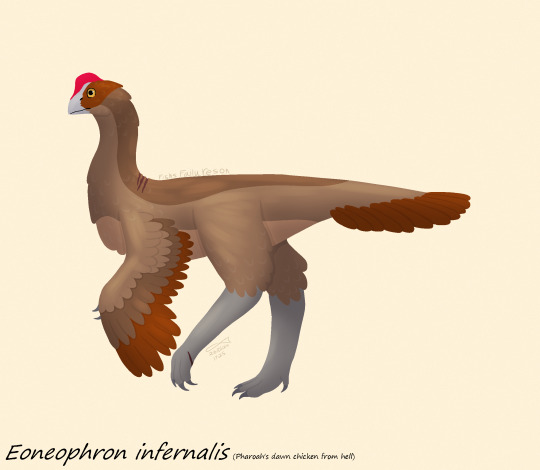
New dinosaur just dropped
#art#my art#digital art#paleoart#paleontology#palaeoblr#archosaurs#dinosaurs#theropods#coelurosaurs#maniraptorans#oviraptorosaurs#caenagnathids#eoneophron#queue
48 notes
·
View notes
Text

Originally known only from a foot, with scarce remains found since, Elmisaurus rarus means “Rare Foot Sole Lizard.” Even today, Elmisaurus fossils are highly fragmentary, as are most Caenagnathid remains, and consist mostly of foot and hand bones. However, if the fossils of Nomingia gobiensis can actually be attributed to Elmisaurus, which they may be, we might have a bigger picture of the animal. Elmisaurus has been the subject of but one study so far, where 23 foot bones from various specimens were studied for signs of stress fracture, and none were found. This animal was probably lightly built and not using its feet for strenuous activities. Rather, like other oviraptorosaurs, it would have relied on a sharp beak and strong bite force, lending to either herbivory of tough plant material or omnivory of both plants and small creatures.

Found in Late Cretaceous Mongolia, Elmisaurus rarus would have lived in the arid canyons of the Nemegt Formation. This environment was not entirely desert like the older Barun Goyot and Djadochta Formations, but also filled with thickly wooded forests of tall conifer trees and shallow lakes. It would have shared this environment with other oviraptorosaurs like Rinchenia, Nemegtomaia, and Avimimus. It would have also lived alongside troodontids like Tochisaurus and would have had to look out for Tyrannosaurs like Bagaraatan and Tarbosaurus. Hadrosaurs like Barsboldia and Saurolophus, the pachycephalosaurs Homalocephale and Prenocephale, sauropods like Nemegtosaurus, and the crocodylomorph Paralligator also lived here, as well as turtles, frogs, and small mammals.

If Nomingia is actually Elmisaurus, then it would have also lived alongside ornithomimosaurs like Anserimimus, Gallimimus, and Deinocheirus, the dromaeosaur Adasaurus, the bird Brodavis, alvarezsaurs like Mononykus, troodontids like Zanabazar, and Therizinosaurus in the Bügiin Tsav locality of the Nemegt Formation.


This art may be used for educational purposes, with credit, but please contact me first for permission before using my art. I would like to know where and how it is being used. If you don’t have something to add that was not already addressed in this caption, please do not repost this art. Thank you!
#my art#Elmisaurus rarus#Elmisaurus#caenagnathid#oviraptorosaurs#theropods#saurischians#dinosaurs#archosaurs#archosauromorphs#reptiles#Nemegt Formation#Late Cretaceous#Mongolia
12 notes
·
View notes
Text

"Leaping Hell Chickens"
The newly discovered Caenagnathid Oviraptor-line dinosaur called Eoneophron infernalis (Dawn Neophron of hell). This emu sized theropod lived in the upper Cretaceous Hell Creek formation in South Dakota.
It was described as a new species from remains that were previously attributed to another Caenagnathid species called Anzu wyliei. The paper that described it, Atkins-Weltman et al. 2024, recovered it as closely related not to Anzu but another Caenagnathid called Elmisaurus.
#artists on tumblr#paleoblr#paleoart#traditional drawing#paleomedia#dinosaurs#dinosaur#oviraptor#hell creek formation#cretaceous#caenagnathid#eoneophron#homage#charles r knight reference
35 notes
·
View notes
Text

chirostenotes pergracilis - caenagnathid - late cretaceous
this fluttery chirostenotes is accompanied by her (barely visible and Only Ten Pixel Wide) lovely little siblings tonight! named for their oddly narrow hands and one pointed, straight claw, this oviraptorosaur was thought to have used its talons for crevasse probing like modern day eye-eye. the representation here has feathers (that other caenag that wouldn't have allowed for it to do as such, sadly!
higher resolution version under the cut!
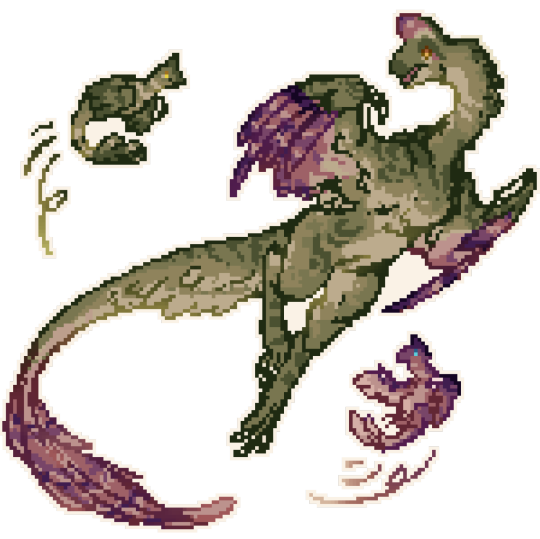
#paleoart#paleoblr#dinosaur#caenagnathid#chirostenotes#id like to think relatives got to stay in their flocks long enough to see their siblings be born :] maybe play with them a little. as a tre#if i made any typos No I Didnt#i just a little eepy so. two tonight two tomorrow <:)#the dinosaur shape ever. feathered and sillay#5/22/23
32 notes
·
View notes
Text
Eoneophron

Caenagnathids like Eoneophron can be differentiated from other oviraptorosaurs by their jaws, which were generally long and shallow, suggesting a less powerful bite. Caenagnathids were also more lightly built, with slender arms and long gracile legs, though they weren't especially cursorial. Eoneophron's body mass is estimated at about 78 kg.
52 notes
·
View notes
Text
Eoneophron infernalis Skeletal
enter: Eoneophron infernalis, a new caenagnathid from the Maastrichtian of the Hell Creek Fm., congrats to Atkins-Weltman et al., (2024) on the publication
THERE IS AN UPDATED VERISON NOW! you can click here to see it.
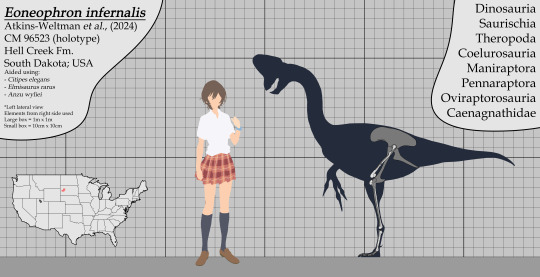
#paleoart#paleontology#digital art#artists on tumblr#digital artwork#palaeoart#digital illustration#sciart#id in alt text#dinosaur#Caenagnathidae#Eoneophron#Eoneophron infernalis#skeletal#scientific diagram#scicomm#science communication#Kase Yamato#asagao to kase san
96 notes
·
View notes
Text
Who is flashiest tailed birb group??? vote now on phones!!!
#palaeoblr#dinosaurs#poll#raptors#birds#I know dromaeosaurs will probably win but I can dream and hope right?#chickenparrots#anzu#velociraptor#stenonychosaurus#anchiornis#archaeopteryx#confuciusornis#yi
99 notes
·
View notes
Text
I should start catching my creature posts up on tumblr to where they are on twitter teehee
Expect more from me soonish, maybe even later today idk

"Xerqyi (Zehr-ch-yee) are one of the largest oviraptorids of Shaikel, only rivaled by the Emperor Cockatrice of the Southern Continent, Tonjuikea. Xerqyi are Caenagnathid Oviraptorosaurs, they live in the dense forests of Wojuikea in large herds, these herds comprising of on average 1 rooster, 5 to 8 hens, and a varying ammount of chicks depending on the season, or Batchelor or Bachelorette groups of up to 10 individuals.
Xerqyi are territorial, especially when chicks are nearby so studying them has been dangerous but we have gathered as much information as possible.
Xerqyi are omnivorous, they are highly generalist animals and feed on all manner of plants and predominantly scavenge meat, although im sure Xerqyi hunt small animals and young on occasion. Xerqyi males have vibrant head crests covered in feathers, this display is made up of blues and greens, their wings are black and the spots in the feathers are a loud iridescent yellow that reflects light to a degree it could temporarily or even permanently blind any potential predator, this is suspected to be the reason both males and females possess these display feathers. Both sexes are predominantly dark brown and white, they patterning on their bodies helping them blend in to their forested homes, presumably mainly used by young to hide as adults can easily fend off troops of Polar Sphinx and packs of Black Dashers. Xerqyi chicks are forced out of the flock during late adolescence and often continue living with their siblings until reaching early adulthood where they split off to form their own herds.
Xerqyi take about 8 years to grow to adulthood and live up to nearly 40 years. Xerqyi nests and the nests of other polar oviraptorosaurs are different from those of more tropical species, polar oviraptorosaurs, commonly known as Snowy Cockatrice typically build their nests out of insulating twigs, foliage, and integument scavenged from other animals. These nests are used more as places to store eggs than to incubate them, eggs are overall safer and warmer being carried by their parents, Snowy Cockatrice hold their eggs close to their bodies to ensure they are warm and safe, Snowy Cockatrice chicks are also often held by their parents to avoid losing them in deep snow, however these chicks hatch with long legs to aid in avoiding that once they start walking.
Xerqyi and other Snowy Cockatrice are covered in dense, shaggy feathers made for trapping heat, as well as having complex nasal passages to warm air as it enters the animal's body, chicks are especially fluffy to keep warm, as adorable as they are it's worth pointing out again that approaching a Xerqyi will most definitely end in you being mauled by one or more very angry elephant sized parents.
It is unknown whether or not Xerqyi are directly related to Earth's Gigantoraptor but studies show they're most likely not, it's more likely Xerqyi are descendants of much smaller Caenagnathids that adapted to living in the colder regions of Shaikel before growing large, it's suspected this large size was only aquired due to the absence of large Saurolophin Hadrosaurs in the region after a minor extinction, however Xerqyi now face some competition from the Moosegeese that grew in their place, as well as the relatively newly arriving Royal Camels, a giant species of camel adapted to the cold." - Shaikei Naturalist, Alver Swan
#dinosaurs#dinosaur#spec evo#speculative evolution#speculative biology#speculative zoology#gigantoraptor#oviraptor#new to tumblr#artwork#art#alt text#shaikel
3 notes
·
View notes
Text
7 Part Slide Show
Tubular Structures on the spine were found that don't exist in modern birds.
Skeletons of North America "Hell Creek" Birds from 40 to 50 million years ago in the Eocene.
News Article
Scientific Research Paper
Caenagnathidae is a clade of derived, Late Cretaceous oviraptorosaurian theropods from Asia and North America. Because their remains are rare and often fragmentary, caenagnathid diversity is poorly understood.
#paleontology#science article#science research#fossils#cretaceous period#eocene#birds#biology#evolution#hell creek formation
0 notes
Text
If you like seeing creative paleoart where extinct creatures look like they could be actual real animals, you need to go look at All Your Yesterdays right now! It's a gorgeous book of speculative paleoart that can be downloaded for free off the publishers' website. I'm about halfway through right now and want to show off just a few of my favourites so far:

A Microraptor eating some fruit by Emily Willoughby

A black Smilodon by Carlos de Miguel Chaves

And my favourite, these beautiful gay Caenagnathids by Julio Lacerda.
There's also a lot of really cool and sometimes funny examples of creatures just doing unusual animal stuff, like climbing a tree or going into a cave despite those not being their habitats, playing in mud, and using sticks as tools.
Content warnings for arachnaphobia on page 43, necrophilia on pages 48/49, tokophobia on pages 86/87, and occasional mildly graphic injury and death.
#all your yesterdays#paleoart#microraptor#smilodon#caenagnathids#i wanna hug to the my boys#dinosaurs said gay rights#seriously this book is amazing#i had to limit myself to posting just three of the gorgeous artworks in it#because i could just post half the book tbh#dinosaur
166 notes
·
View notes
Text

Day 9- Hagryphus
#art#my art#digital art#paleoart#dinovember#paleontology#palaeoblr#dinosaurs#coelurosaurs#oviraptorisaurians#caenagnathids#hagryphus#queue
22 notes
·
View notes
Text
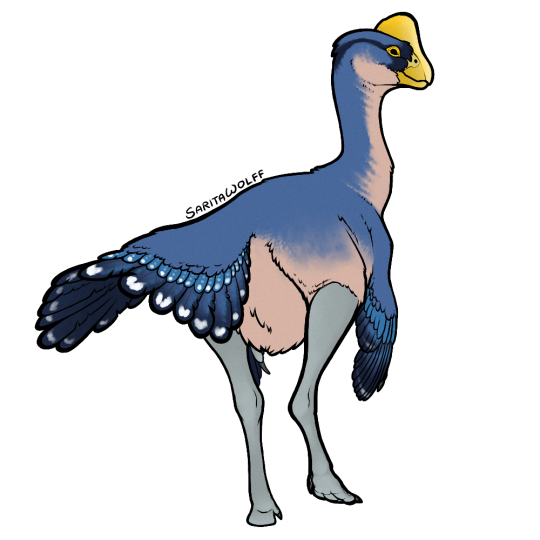
The gracile caenagnathids are notorious for fossilizing badly, and as such Nomingia gobiensis is only known from its spine, upper legs, and tail (which is honestly more than most other caenagnathids). However, its tail represents a significant discovery for oviraptorosaurs. Nomingia had five fused vertebrae at the tip of its tail, a structure similar to the pygostyle of birds, that would have supported a fan of tail feathers. When Nomingia was found in 1994 and described in 2000, this feature was thought to be unique to birds. And while we have evidence of tail fans in other oviraptorosaurs, pygostyles themselves are rare. It’s unknown why Nomingia would have needed this, as it was certainly too big for flying. Perhaps, like Khaan’s tail fan, it was used for display, and the structure would have allowed it to have a sturdier, larger, more “sexy” tail fan.

As of 2021, it has been suggested that Nomingia may actually be Elmisaurus, but further study is needed to confirm this. Since caenagnathid fossils tend to be so fragmentary, this may take some time.
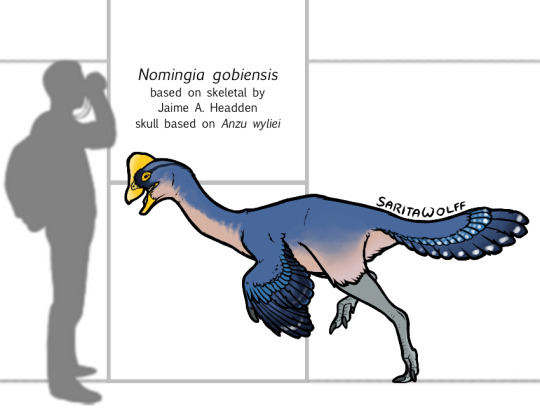
Hailing from the Bügiin Tsav and Nemegt localities of Mongolia’s Late Cretaceous Nemegt Formation, Nomingia would have lived alongside Avimimus nemegtensis in this seasonally arid environment characterized by cliffs, shallow lakes, and patches of conifer forests. If not Elmisaurus itself, it would have lived alongside it as well as the oviraptorids Nemegtomaia in the Nemegt and Oksoso in the Bügiin Tsav. There were of course other dinosaurs here, including Therizinosaurus, the troodontid Tochisaurus, the tyrannosaur Bagaraatan, the sauropod Nemegtosaurus, the hadrosaur Barsboldia, and the pachycephalosaur Homalocephale in the Nemegt.
In the Bügiin Tsav, Nomingia would have lived alongside the troodontid Zanabazar, the dromaeosaur Adasaurus, the bird Brodavis, the ornithomimosaurs Anserimimus and Deinocheirus, and the alvarezsaur Mononykus.
It would have come across Gallimimus, the hadrosaur Saurolophus, the pachycephalosaur Prenocephale, and the tyrannosaur Tarbosaurus in both localities. Crocodylomorphs like Paralligator, fish like Harenaichthys, and turtles could be found in the freshwater lakes.


This art may be used for educational purposes, with credit, but please contact me first for permission before using my art. I would like to know where and how it is being used. If you don’t have something to add that was not already addressed in this caption, please do not repost this art. Thank you!
#Nomingia gobiensis#Nomingia#caenagnathid#oviraptorosaurs#theropods#saurishcians#dinosaurs#archosaurs#archosauromorphs#reptiles#SaritaDrawsPalaeo#Nemegt Formation#Late Cretaceous#Mongolia
15 notes
·
View notes
Text
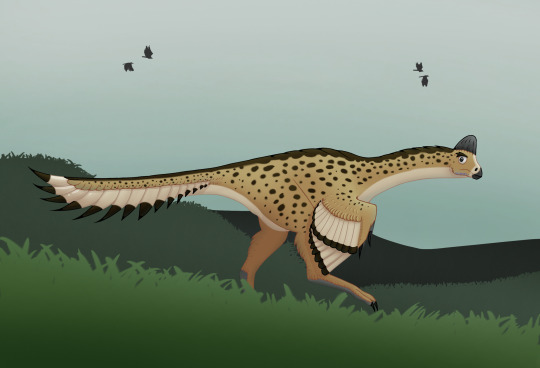
Anzu wyliei.
#dino#dinosaur#dinosaurs#paleo#art#digital art#paleoart#palaeoblr#prehistoric#anzu wyliei#anzu#illustration#theropod#caenagnathidae#caenagnathid#feathered dinosaurs#one of the most underrated groups of dinosaurs ever#feathered toes should be drawn on more dinosaurs imo#feathered dinosaur
49 notes
·
View notes
Video
tumblr
Anzu is a caenagnathid dinosaur genus from North Dakota, South Dakota, and Montana that lived during the Late Cretaceous period in what is now the Hell Creek Formation. Anzu wyliei is the type species and the only species known from several skeletons that maintain cranial and postcranial features.
#anzu#dinosaur#dinosaurs#dino#dinos#theropod#oviraptorosaur#hell creek#rocky mountain dinosaur resource center#museum#nature#paleontology#fossil#fossils
78 notes
·
View notes
Text

Anzu wyliei, one of my favourite oviraptorosaurs and for sure my favourite caenagnathid (sorry Gigantoraptor). Main inspiration with this reconstruction was hornbills. Referenced from Scott Hartman.
146 notes
·
View notes
Text


#Archovember Day 25 - Pachycephalosaurus wyomingensis
I try to include a Pachycephalosaurid in every Archovember, but I have been dancing around drawing the Big One. Until now.
From Late Cretaceous North America, Pachycephalosaurus wyomingensis was a bipedal herbivore that may have also eaten insects and meat due to its bladelike front teeth. It is of course most well known for its extremely thick, domed skull. Initially, it was thought that these skull domes were used for intraspecies conflict, and that males would headbutt each other in a matter similar to bighorn sheep and musk oxen. However, this hypothesis is more recently up for debate. The rounded shape of the skull and the orientation of the cervical vertebrae seem unfit for the stress of direct head-butting. One study suggests that Pachycephalosaurs would use their skulls to strike rivals in the flank, as their broad torsos would have protected their vital organs. Even so, histological studies have shown that Pachycephalosaur domes were made of a unique fibrolamellar bone that would have been able to heal injuries relatively quickly. So head-on headbutting seems to still be a possibility.
Two other Pachycephalosaurids have been found in the Hell Creek Formation: Dracorex hogwartsia and Stygimoloch spinifer. These pachycephalosaurs were smaller and had flat skulls. But Dracorex and Stygimoloch have only been found as juveniles, and Pachycephalosaurus have only been found as adults. As they lived in the same time period and area, most paleontologists agree that Dracorex and Stygimoloch were different growth stages of Pachycephalosaurus, and that it would grow its domed skull as it matured. (Of note though is that all Stygimoloch specimens have been collected from the upper part of the Hell Creek Formation, and all Pachycephalosaurus’ were collected from the lower part. So Stygimoloch still may be it’s own species.)
Late Cretaceous North America was home to some of the most famous dinosaurs, so Pachycephalosaurus wyomingensis would have lived alongside many familiar faces. These include the hadrosaurid Edmontosaurus, ceratopsians like Triceratops, Torosaurus, Nedoceratops, Tatankaceratops, and Leptoceratops, ankylosaurians like Ankylosaurus, Denversaurus, and Edmontonia, the neoornithiscian Thescelosaurus, the dromaeosaurs Dakotaraptor and Acheroraptor, the ornithomimids Ornithomimus and Struthiomimus, the Caenagnathids Anzu and Leptorhynchos, and of course, the tyrannosaurid Tyrannosaurus rex. There were also many species of frogs, salamanders, fish, turtles, birds, mammals, at least two species of pterosaur, the choristoderan Champsosaurus, and crocodylomorphs like Borealosuchus and Brachychampsa.
14 notes
·
View notes